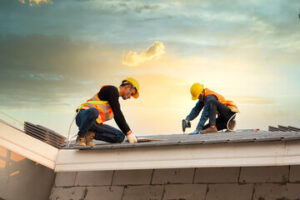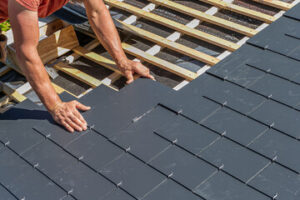Roofing is one of the most important aspects of a building. Without roofers, buildings would be susceptible to structural damage, water leaks, and compromised energy efficiency.

Understanding the basics of roofing can empower homeowners, allowing them to make informed decisions when selecting materials and contractors for their projects. This guide will cover everything from the types of roofs to their maintenance requirements. Visit https://www.bostonroofingco.com/ to learn more.
Whether you’re building a new home or replacing an existing roof, choosing the right roofing material is a major decision that will impact the performance and value of your home. The type of material you select will depend on many factors, including your budget and location. Some materials are more expensive than others, while some can withstand harsh weather conditions better than others. A quality roofing material will protect your home from the elements and add to its resale value.
A popular choice for homes in warmer climates is clay tiles, which are made from earthen clays molded into rolled or interlocking shapes and fired for durability. They are a durable option for hot climates and can resist high winds, earthquakes, tornadoes, and hurricanes. The drawback to clay tiles is that they are quite heavy, and they require a strong structure to support them. They also become more fragile in cold weather and may need extra reinforcement.
Other types of roof materials include wood shingles and shakes, metal shingles and tiles, concrete shingles and tiles, and asphalt shingles. Asphalt shingles are the most common, as they’re affordable and easy to install. They can be prone to moss and mildew, however. Concrete shingles and tiles are an attractive, long-lasting option that adds a unique aesthetic to your home. They’re durable, aesthetically pleasing, and can withstand a variety of weather conditions.
Rolled roofing is a cost-effective and convenient option for low-sloped residential roofs and utilitarian structures such as sheds and garages. It’s available in a wide range of colors and finishes to suit any style.
There are also various roofing products that provide energy efficiency and other innovative features. Discuss the options with your contractor to find a product that best suits your needs and budget. New roofing materials also come with a manufacturer warranty, which can help reduce your repair and replacement costs in the future.
Installation
The roof is the main barrier between the interior of a building and the outside elements. It protects the space and its occupants from the elements, maintains a comfortable temperature, and prevents water damage to other parts of the structure. In order to properly function, the roof must be installed and maintained correctly. Roofing is a complex process that requires the use of specific tools and equipment, including hammers, nail guns, ladders, shingle cutters, hard hats, and harnesses for workers on taller jobs.
Before any work can begin on your roof, the contractor will prepare the area. This includes removing any existing materials and covering surrounding areas with tarps to protect them from falling debris. The team will also inspect the decking to make sure it is structurally sound and capable of supporting the new roofing.
Once the prep work is complete, the roofer will install underlayment and felt paper. The underlayment helps to keep the shingles secure, while the felt paper protects against water vapor that could otherwise get into the interior of your home. The shingles are then installed in rows, starting at the bottom of the roof and working towards the top. The shingles are nailed down using a specific pattern, with nails closer together near the edges and more spread out near the middle.
The shingles are then covered with flashing and drip edge flashing to protect the eaves, roof valleys, and ice and water sheathing. Flashing is also needed around chimneys, wood stove pipes, certain vents, and along hip roofs.
Maintenance
A roof is one of the most important components in any structure, protecting its inhabitants from harsh weather elements. It is also responsible for a building’s thermal comfort. To ensure the longevity of a roof, it is recommended that homeowners engage in preventive maintenance. By regularly inspecting the roof and addressing small problems, they can protect their investments and extend the lifespan of their homes.
Roof inspections should be performed on a regular basis, ideally twice per year (once in the spring and once in fall). These inspections should also be conducted following extreme weather events to detect any potential damage that may have occurred. This allows for timely repairs to be made, before the problem exacerbates.
When conducting a roof inspection, it is advisable to note any areas of excessive shingle wear and tear, as well as any shingles that are outright missing. Additionally, it is important to check for cracking and rusting of the flashing. It is critical that the flashing be properly caulked, so water does not seep into penetrations such as chimneys and vent pipes. It is also a good idea to inspect and re-caulk the flashing around skylights, exhaust fans and air conditioning units.
Additionally, it is a good idea to trim trees on the property that hang over the roof. This will reduce the chance of them contacting the roof in high winds and causing damage. It is also a good idea to perform a visual inspection of the entire roofing system, including soffit and fascia. This will help to prevent pests from accessing the interior of a home, and it will also allow for a quick detection of any wood rot or insect infestations.
Warranty
The warranty offered by a roofing company is a key consideration in your selection process. You should be sure to only work with contractors who are willing to guarantee their workmanship through a warranty. This will provide you with peace of mind should any problems arise after the installation is completed.
There are several different types of warranties available from shingle manufacturers and roofing contractors. You should be familiar with the terms of each type of warranty so that you can make an educated decision about which is right for your home.
Manufacturer warranties generally cover both the materials and the labor to install those materials. The manufacturer will replace or repair any defective products during a set warranty period, which may last up to 50 years for shingles and up to 25 for metal.
In addition, some manufacturers also offer a workmanship warranty that covers the labor required to repair or replace a roof. This is typically only available if you work with a roofing contractor who has been certified by the manufacturer to perform certain services.
It is important to keep in mind that a manufacturer warranty can be voided by the homeowner, which can be very frustrating. It is not uncommon to find that homeowners have unknowingly done something that will void the warranty, such as failing to schedule regular maintenance inspections or changing roof coverings without getting permission from the manufacturer.
There are also a number of other issues that can void the manufacturer warranty, including bringing in another contractor to perform repairs or replacing a roof with an inferior product. It is best to be aware of these potential issues so that you do not run into any problems down the road.
Whether or not you choose to purchase a roof warranty is a personal decision that depends on your budget and level of risk tolerance. However, you should never feel pressured by a roofing contractor to purchase a warranty if you are not comfortable with the terms.
